1. GBD 2019 Tobacco Collaborators. Spatial, temporal, and demographic patterns in prevalence of smoking tobacco use and attributable disease burden in 204 countries and territories, 1990-2019: a systematic analysis from the Global Burden of Disease Study 2019. Lancet. 2021; 397:2337–2360. PMID:
34051883.
3. U.S. Department of Health and Human Services, Centers for Disease Control and Prevention, National Center for Chronic Disease Prevention and Health Promotion, Office on Smoking and Health. Smoking cessation. A report of the surgeon general. Atlanta (GA): U.S. Department of Health and Human Services;2020.
4. Doll R, Peto R, Boreham J, Sutherland I. Mortality in relation to smoking: 50 years’ observations on male British doctors. BMJ. 2004; 328:1519. PMID:
15213107.

5. Yusuf S, Hawken S, Ounpuu S, et al. Effect of potentially modifiable risk factors associated with myocardial infarction in 52 countries (the INTERHEART study): case-control study. Lancet. 2004; 364:937–952. PMID:
15364185.
6. Visseren FLJ, Mach F, Smulders YM, et al. 2021 ESC Guidelines on cardiovascular disease prevention in clinical practice. Eur Heart J. 2021; 42:3227–3337. PMID:
34458905.
7. Holthuis EI, Visseren FLJ, Bots ML, Peters SAE. UCC-SMART study group. Risk factor clusters and cardiovascular disease in high-risk patients: the UCC-SMART study. Glob Heart. 2021; 16:85. PMID:
35141126.

8. Chen S, Che Q, Zheng Q, et al. Relationship between different risk factor patterns and follow-up outcomes in patients with ST-segment elevation myocardial infarction. Front Cardiovasc Med. 2021; 8:633992. PMID:
34113659.
9. Peters SAE, Wang X, Lam TH, et al. Clustering of risk factors and the risk of incident cardiovascular disease in Asian and Caucasian populations: results from the Asia Pacific Cohort Studies Collaboration. BMJ Open. 2018; 8:e019335.

10. Wilson PW, Kannel WB, Silbershatz H, D’Agostino RB. Clustering of metabolic factors and coronary heart disease. Arch Intern Med. 1999; 159:1104–1109. PMID:
10335688.
11. Seo MH, Lee WY, Kim SS, et al. 2018 Korean Society for the Study of Obesity guideline for the management of obesity in Korea. J Obes Metab Syndr. 2019; 28:40–45. PMID:
31089578.
12. Briasoulis A, Agarwal V, Messerli FH. Alcohol consumption and the risk of hypertension in men and women: a systematic review and meta-analysis. J Clin Hypertens (Greenwich). 2012; 14:792–798. PMID:
23126352.

13. Bull FC, Al-Ansari SS, Biddle S, et al. World Health Organization 2020 guidelines on physical activity and sedentary behaviour. Br J Sports Med. 2020; 54:1451–1462. PMID:
33239350.

14. Jeong SM, Jeon KH, Shin DW, et al. Smoking cessation, but not reduction, reduces cardiovascular disease incidence. Eur Heart J. 2021; 42:4141–4153. PMID:
34431997.

15. Levey AS, Bosch JP, Lewis JB, Greene T, Rogers N, Roth D. A more accurate method to estimate glomerular filtration rate from serum creatinine: a new prediction equation. Modification of Diet in Renal Disease Study Group. Ann Intern Med. 1999; 130:461–470. PMID:
10075613.

16. Kim RB, Kim HS, Kang DR, et al. The trend in incidence and case-fatality of hospitalized acute myocardial infarction patients in Korea, 2007 to 2016. J Korean Med Sci. 2019; 34:e322. PMID:
31880418.
17. Korea Disease Control and Prevention Agency. Korea Health Statistics 2020: Korea National Health and Nutrition Examination Survey (KNHANES VIII-2). Cheongju: Korea Disease Control and Prevention Agency;2020.
18. U.S. Department of Health and Human Services, Centers for Disease Control and Prevention, National Center for Chronic Disease Prevention and Health Promotion, Office on Smoking and Health. How Tobacco Smoke Causes Disease: The Biology and Behavioral Basis for Smoking-Attributable disease. A Report of the Surgeon General. Atlanta (GA): U.S. Department of Health and Human Services;2010.
19. Khan RJ, Stewart CP, Davis SK, Harvey DJ, Leistikow BN. The risk and burden of smoking related heart disease mortality among young people in the United States. Tob Induc Dis. 2015; 13:16. PMID:
26146496.

20. U.S. Department of Health and Human Services, Centers for Disease Control and Prevention, National Center for Chronic Disease Prevention and Health Promotion, Office on Smoking and Health. Preventing Tobacco Use Among Youth and Young Adults. A Report of the Surgeon General. Atlanta (GA): U.S. Department of Health and Human Services;2012.
21. Jee Y, Jung KJ, Lee S, Back JH, Jee SH, Cho SI. Smoking and atherosclerotic cardiovascular disease risk in young men: the Korean Life Course Health Study. BMJ Open. 2019; 9:e024453.
22. Banks E, Joshy G, Korda RJ, et al. Tobacco smoking and risk of 36 cardiovascular disease subtypes: fatal and non-fatal outcomes in a large prospective Australian study. BMC Med. 2019; 17:128. PMID:
31266500.
23. Powell-Wiley TM, Poirier P, Burke LE, et al. Obesity and cardiovascular disease: a scientific statement from the American Heart Association. Circulation. 2021; 143:e984–1010. PMID:
33882682.

24. Wienbergen H, Guenther K, Boakye D, et al. Risk factors in young patients with myocardial infarction: what is different from the general population? Eur Heart J. 2021; 42:ehab724.2400.

25. Korea Disease Control and Prevention Agency. Korean National Health and Nutritional Examination Survey (KNHANES) Fact Sheet: The 20-Year (1988-2018) Trends in Health Behaviors and Chronic Diseases 2020. Cheongju: Korea Disease Control and Prevention Agency;2020. cited 2022 Jun 1. Available from:
http://knhanes.kdca.go.kr
.
26. Williams JM, Steinberg ML, Griffiths KG, Cooperman N. Smokers with behavioral health comorbidity should be designated a tobacco use disparity group. Am J Public Health. 2013; 103:1549–1555. PMID:
23865661.

27. Forman-Hoffman VL, Hedden SL, Glasheen C, Davies C, Colpe LJ. The role of mental illness on cigarette dependence and successful quitting in a nationally representative, household-based sample of U.S. adults. Ann Epidemiol. 2016; 26:447–454. PMID:
27247163.

28. Carroll AJ, Carnethon MR, Liu K, et al. Interaction between smoking and depressive symptoms with subclinical heart disease in the Coronary Artery Risk Development in Young Adults (CARDIA) study. Health Psychol. 2017; 36:101–111. PMID:
27736150.
29. Jung-Choi KH, Khang YH, Cho HJ. Hidden female smokers in Asia: a comparison of self-reported with cotinine-verified smoking prevalence rates in representative national data from an Asian population. Tob Control. 2012; 21:536–542. PMID:
21972062.
30. Park JB, Kim DH, Lee H, et al. Mildly abnormal lipid levels, but not high lipid variability, are associated with increased risk of myocardial infarction and stroke in “Statin-Naive” young population a nationwide cohort study. Circ Res. 2020; 126:824–835. PMID:
31978313.
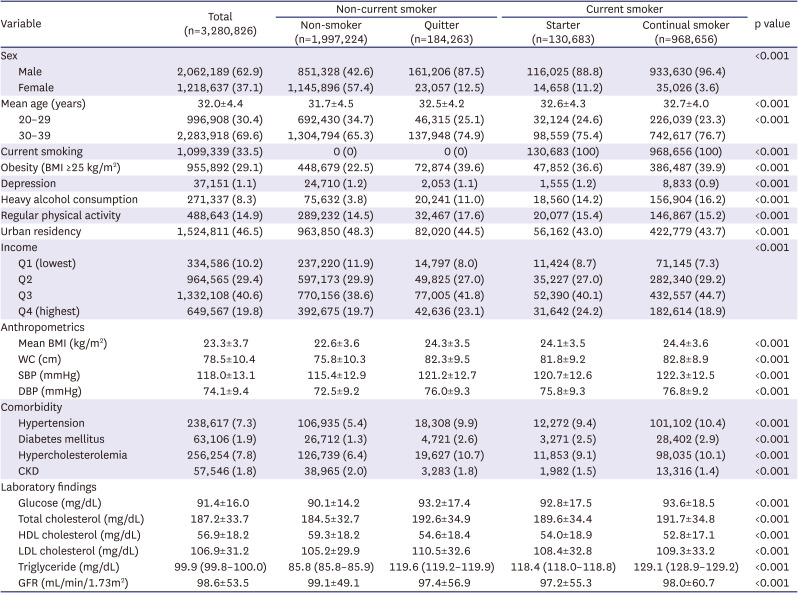
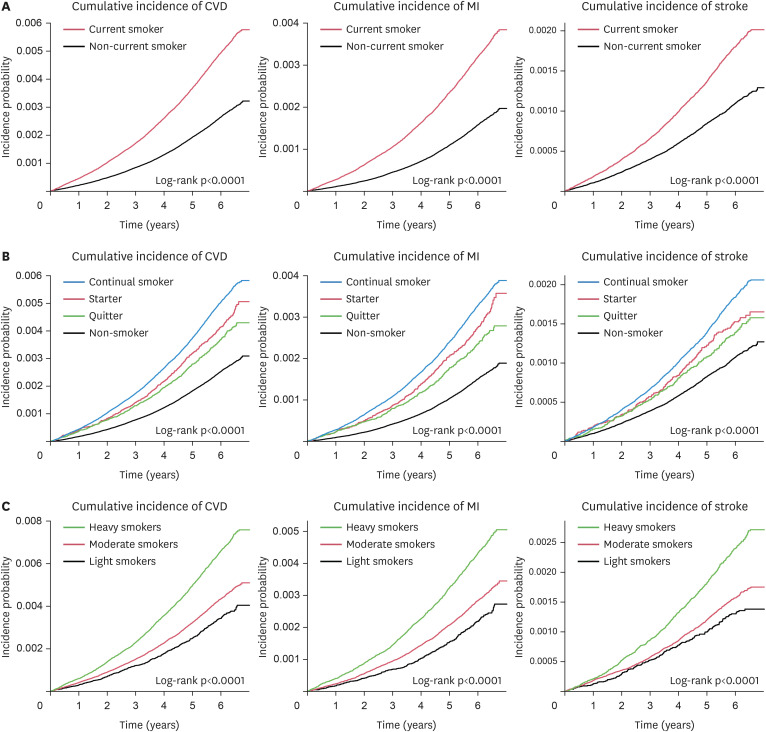
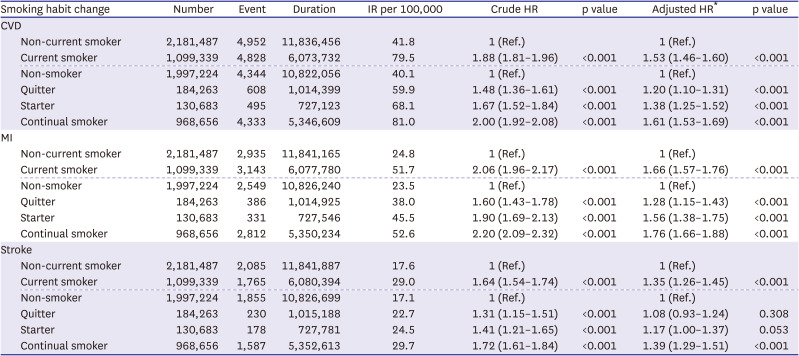
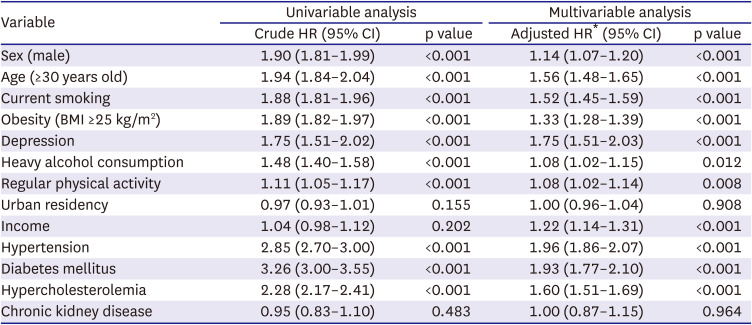
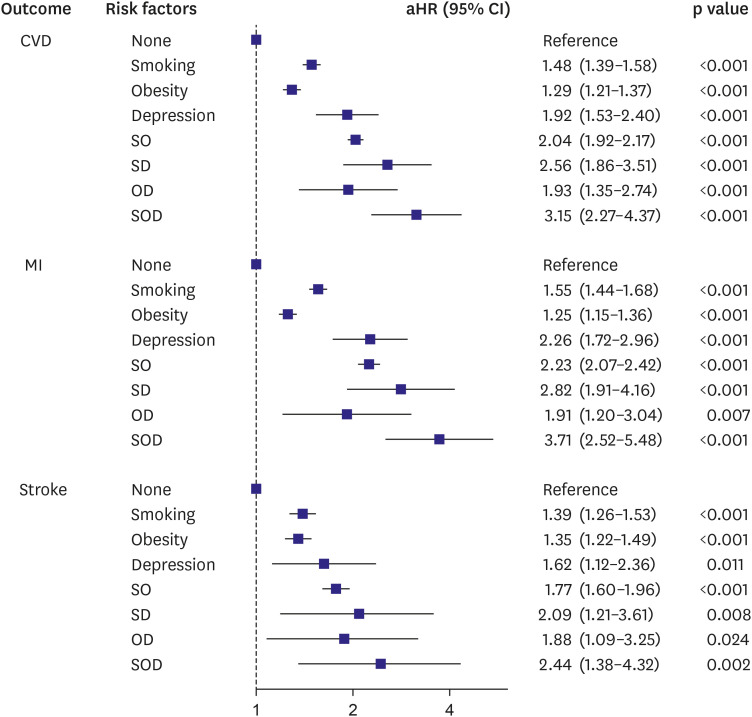




 PDF
PDF Citation
Citation Print
Print



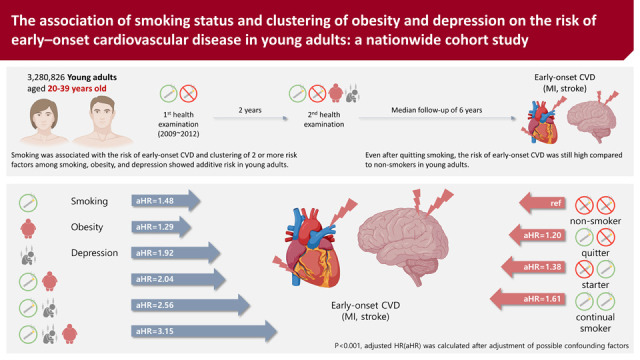
 XML Download
XML Download